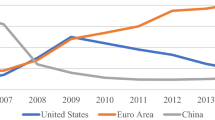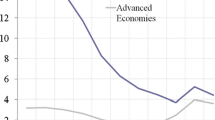Abstract
This article empirically investigates whether the level of non-performing loans (NPLs) affects the bank lending behaviour using the bank-level data across 42 countries, spanning over the period from 2000 to 2017. We find a negative and statistically significant relationship between NPL and bank loan growth. This impact is not geographically restricted and is confirmed for the EU, non-EU, advanced, and emerging countries subsamples. We also examine the channels through which NPLs affect loan growth. Our results show that the association between NPL and loan growth is more pronounced for well-capitalized banks. We find no evidence in support of an effect of asset management companies on the negative association between NPLs and loan growth. In addition, our results are robust with respect to alternative measure of credit risk and different specifications.
Similar content being viewed by others
Notes
The impact of NPL on growth lending in the fixed effect model is 0.0027, see Table 4.
References
Abdul-Karim, M., M.K. Hassan, T. Hassan, and S. Mohamad. 2014. Capital adequacy and lending and deposit behaviors of conventional and Islamic banks. Pacific Basin Finance Journal 28: 58–75.
Aiyar, S., W. Bergthaler, J.M. Garrido, A. Ilyina, A. Jobst, and K. Kang. 2015. A strategy for resolving europe’s problem loans. International Monetary Fund 15: 1–37.
Allen, F., K. Jackowicz, O. Kowalewski, and Ł Kozłowski. 2017. Bank lending, crises, and changing ownership structure in Central and Eastern European countries. Journal of Corporate Finance 42: 494–515.
Arellano, M., and S. Bond. 1991. Some tests of specification for panel data: Monte Carlo evidence and an application to employment equations. The Review of Economic Studies 58 (2): 277.
Arellano, M., and O. Bover. 1995. Another look at the instrumental variable estimation of error-components models. Journal of Econometrics 68 (1): 29–51.
Athanasoglou, P.P., S.N. Brissimis, and M.D. Delis. 2008. Bank-specific, industry-specific and macroeconomic determinants of bank profitability. Journal of International Financial Markets, Institutions and Money 18 (2): 121–136.
Baum, C.F. 2006. An Introduction to Modern Econometrics Using Stata. Stata Corp.
Baum, Christopher F., M.E. Schaffer, and S. Stillman. 2003. Instrumental variables and GMM: Estimation and testing. Stata Journal 3 (1): 1–31.
Berger, A.N., and G.F. Udell. 2006. A more complete conceptual framework for SME finance. Journal of Banking and Finance 30 (11): 2945–2966.
Blundell, R., and S. Bond. 1998. Initial conditions and moment restrictions in dynamic panel data models. Journal of Econometrics 87 (1): 115–143.
Bonin, J.P., I. Hasan, and P. Wachtel. 2005. Bank performance, efficiency, and ownership in transition countries. Journal of Banking and Finance 29 (1): 31–53.
Cantero-Saiz, M., S. Sanfilippo-Azofra, B. Torre-Olmo, and C. López-Gutiérrez. 2014. Sovereign risk and the bank lending channel in Europe. Journal of International Money and Finance 47: 1–20.
Cantú, C., S. Claessens, and L. Gambacorta. 2019. How do bank-specific characteristics affect lending? New evidence based on credit registry data from Latin America. Bank for International Settelments (BIS) Working Paper, No. 798.
Carlson, M., H. Shan, and M. Warusawitharana. 2013. Capital ratios and bank lending: A matched bank approach. Journal of Financial Intermediation 22 (4): 663–687.
Chavan, P., and L. Gambacorta. 2019. Bank lending and loan quality: An emerging economy perspective. Empirical Economics 57 (1): 1–29.
Cucinelli, D. 2015. The impact of non-performing loans on bank lending behavior: Evidence from the Italian banking sector. Eurasian Journal of Business and Economics 8 (16): 59–71.
Cucinelli, D. 2016. Can speed kill? The cyclical effect of rapid credit growth: Evidence from bank lending behavior in Italy. The Journal of Risk Finance 17 (5): 562–584.
Cheisa, G., and M. Mansilla-Fernández. 2019. Disentangling the transmission channel NPLs-cost of capital-lending supply. Applied Economics Letters 26 (16): 1333–1338.
Chouchène, M., Z. Ftiti, and W. Khiari. 2017. Bank-to-bank lending channel and the transmission of bank liquidity shocks: Evidence from France. Research in International Business and Finance 39: 940–950.
Deli, Y.D., and I. Hasan. 2017. Real effects of bank capital regulations: Global evidence. Journal of Banking and Finance 82: 217–228.
Dell’Ariccia, G., and R. Marquez. 2006. Lending booms and lending standards. Journal of Finance 61 (5): 2511–2546.
Dimitrios, A., L. Helen, and T. Mike. 2016. Determinants of non-performing loans: Evidence from euro-area countries. Finance Research Letters 18: 1–4.
Eisdorfer, A. 2008. Empirical evidence of risk shifting in financially distressed firms. Journal of Finance 63 (2): 609–637.
Erdinc, D., and E. Abazi. 2014. The determinants of NPLs in emerging Europe, 2000–2011. Journal of Economics and Political Economy 1 (2): 112–125.
European Central Bank (ECB). 2016. Annual report. Retrieved from https://www.ecb.europa.eu/pub/pdf/annrep/ar2016en.pdf
Fang, X., D. Jutrsa, S.M. Peria, A.F. Presbitero, and L. Ratnovski. 2020. Bank capital requirements and lending in emerging markets: The role of bank characteristics and economic conditions. Journal of Banking and Finance.
Foos, D., L. Norden, and M. Weber. 2010. Loan growth and riskiness of banks. Journal of Banking and Finance 34 (12): 2929–2940.
Gambacorta, L., and P.E. Mistrulli. 2004. Does bank capital affect lending behavior? Journal of Financial Intermediation 13 (4): 436–457.
Gambacorta, L., and H.S. Shin. 2018. Why bank capital matters for monetary policy. Journal of Financial Intermediation 35: 17–29.
Gandrud, C., and M. Hallerberg. 2014. Bad banks in the EU: The impact of eurostat rules. Bruegel Working paper. http://papers.ssrn.com/sol3/papers.cfm?abstract_id=2241290
Ghosh, A. 2015. Banking-industry specific and regional economic determinants of non-performing loans: Evidence from US states. Journal of Financial Stability 20: 93–104.
Gulati, R., A. Goswami, and S. Kumar. 2019. What drives credit risk in the Indian banking industry? An empirical investigation. Economic Systems 43 (1): 42–62.
Hausman, J.A. 1978. Specification tests in econometrics. Econometrica 46 (6): 1251–1271.
Hau, H., S. Langfield, and D. Marques-Ibanez. 2013. Bank ratings: What determines their quality? Economic Policy 13 (April): 289–333.
Hu, J.-L., Y. Li, and Y.-H. Chiu. 2004. Ownership and nonperforming loans: Evidence from Taiwan’s banks. The Developing Economies 42 (3): 405–420.
Ibrahim, M.H., and S.A.R. Rizvi. 2018. Bank lending, deposits and risk-taking in times of crisis: A panel analysis of islamic and conventional banks. Emerging Markets Review 35: 31–47.
Iwanicz-Drozdowska, M., and B. Witkowski. 2016. Credit growth in Central, Eastern, and South-Eastern Europe: The case of foreign bank subsidiaries. International Review of Financial Analysis 43: 146–158.
Jeong, S., and H. Jung. 2013. Bank wholesale funding and credit procyclicality: Evidence from Korea. Panoeconomicus 5: 615–631.
Kabir, N., A. Worthington, and R. Gupta. 2015. Comparative credit risk in Islamic and conventional bank. Pacific Basin Finance Journal 34: 327–353.
Keeton, R., and W. 1999. Does faster loan growth lead to higher loan losses? Economic Review 84 (2): 57–75.
Kishan, R.P., and T.P. Opiela. 2006. Bank capital and loan asymmetry in the transmission of monetary policy. Journal of Banking and Finance 30 (1): 259–285.
Klein, N. 2013. Non-performing loans in CESEE: Determinants and impact on macroeconomic performance. IMF Working Papers 13 (72): 1.
Koodstaal, M., and S.V. Wijnbergen. 2012. On risk, leverage, and banks: Do highly leveraged banks take on excessive risk? SSRN Working Paper 2170008.
Košak, M., S. Li, I. Lončarski, and M. Marinc. 2015. Quality of bank capital and bank lending behavior during the global financial crisis. International Review of Financial Analysis 37: 168–183.
Kuzucu, N., and S. Kuzucu. 2019. What drives non-performing loans? Evidence from emerging and advanced economies during pre- and post-global financial crisis. Emerging Markets Finance and Trade 55 (8): 1694–1708.
Laeven, L., and G. Majnoni. 2003. Loan loss provisioning and economic slowdowns: Too much, too late? Journal of Financial Intermediation 12 (2): 178–197.
Laeven, L., L. Ratnovski, and H. Tong. 2016. Bank size, capital, and systemic risk: Some international evidence. Journal of Banking and Finance 69: S25–S34.
Lehmann, A. 2017. Carving out legacy assets: a successful tool for bank restructuring? Policy Contribution. http://www.europarl.europa.eu/RegData/etudes/IDAN/2017/587397/IPOL_IDA(2017)587397_EN.pdf. (No. 9).
Louhichi, A., and Y. Boujelbene. 2016. Credit risk, managerial behaviour and macroeconomic equilibrium within dual banking systems: Interest-free vs. interest-based banking industries. Research in International Business and Finance 38: 104–121.
Louhichi, A., and Boujelbene, Y. 2017. Bank capital, lending and financing behaviour of dual banking systems. Journal of Multinational Financial Management 41 (September 2008): 61–79.
Louzis, D.P., A.T. Vouldis, and V.L. Metaxas. 2012. Macroeconomic and bank-specific determinants of non-performing loans in Greece: A comparative study of mortgage, business and consumer loan portfolios. Journal of Banking and Finance 36 (4): 1012–1027.
Makri, V., A. Tsagkanos, and A. Bellas. 2014. Determinants of non-performing loans: The case of Eurozone. Panoeconomicus 2: 193–206.
Marinč, M., M. Mrak, and V. Rant. 2014. Dimensions of bank capital regulation: A cross-country analysis. Panoeconomicus 4: 415–439.
Meriläinen, J.M. 2016. Lending growth during the financial crisis and the sovereign debt crisis: The role of bank ownership type. Journal of International Financial Markets, Institutions and Money 41: 168–182.
Micco, A., and U. Panizza. 2006. Bank ownership and lending behavior. Economics Letters 93: 248–254.
O’Brien, R.M. 2007. A caution regarding rules of thumb for variance inflation factors. Quality and Quantity 41 (5): 673–690.
Peek, J., and E. Rosengren. 1995. The capital crunch: Neither a borrower nor a lender be. Journal of Money, Credit and Banking 27 (3): 625–638.
Puri, M., J. Rocholl, and S. Steffen. 2011. Global retail lending in the aftermath of the US financial crisis: Distinguishing between supply and demand effects. Journal of Financial Economics 100 (3): 556–578.
Ranjan, R., and SCh. Dhal. 2003. Non-performing loans and terms of credit of public sector Banks in India: An empirical assessment. Reserve Bank of India Occasional Papers 24 (3): 81–121.
Roodman, D. 2006. How to do xtabond2: An introduction to difference and system GMM in Stata (No. 103). Stata Journal.
Salas, V., and J. Saurina. 2002. Credit risk in two institutional regimes: Spanish commercial and savings banks. Journal of Financial Services Research 22: 203–224.
Sanfilippo-Azofra, S., B. Torre-Olmo, M. Cantero-Saiz, and C. López-Gutiérrez. 2018. Financial development and the bank lending channel in developing countries. Journal of Macroeconomics 55 (October 2017): 215–234.
Schnabl, P. 2012. The international transmission of bank liquidity shocks: Evidence from an emerging market. Journal of Finance 67 (3): 897–932.
Shahzad, F., Z. Fareed, B. Zulfiqar, U. Habiba, and M. Ikram. 2019. Does abnormal lending behavior increase bank riskiness? Evidence from Turkey. Financial Innovation 5 (1): 37.
Stein, J.C. 2002. Information production and capital allocation. Journal of Finance 57 (5): 1891–1921.
Tarchouna, A., B. Jarraya, and A. Bouri. 2017. How to explain non-performing loans by many corporate governance variables simultaneously? A corporate governance index is built to US commercial banks. Research in International Business and Finance 42 (July): 645–657.
Thornton, J., and C. Di Tommaso. 2020. The effect of non-performing loans on credit expansion: Do capital and profitability matter? Evidence from European banks. International Journal of Finance and Economics 26: 4822.
Vithessonthi, C. 2016. Deflation, bank credit growth, and non-performing loans: Evidence from Japan. International Review of Financial Analysis 45: 295–305.
Vo, X.V. 2018. Bank lending behavior in emerging markets. Finance Research Letters 27 (February): 129–134.
Funding
Funding was provided by Javna Agencija za Raziskovalno Dejavnost RS (Grant No. P5-0161) and Erasmus Mundus project Green Tech WB (Grant No. 551984-EM-1-2014-1-ES-ERA MUNDUS-EMA2).
Author information
Authors and Affiliations
Corresponding author
Ethics declarations
Conflict of interest
The authors declare that there is no conflict of interest.
Additional information
Publisher's Note
Springer Nature remains neutral with regard to jurisdictional claims in published maps and institutional affiliations.
Rights and permissions
Springer Nature or its licensor (e.g. a society or other partner) holds exclusive rights to this article under a publishing agreement with the author(s) or other rightsholder(s); author self-archiving of the accepted manuscript version of this article is solely governed by the terms of such publishing agreement and applicable law.
About this article
Cite this article
Gjeçi, A., Marinč, M. & Rant, V. Non-performing loans and bank lending behaviour. Risk Manag 25, 7 (2023). https://doi.org/10.1057/s41283-022-00111-z
Accepted:
Published:
DOI: https://doi.org/10.1057/s41283-022-00111-z




